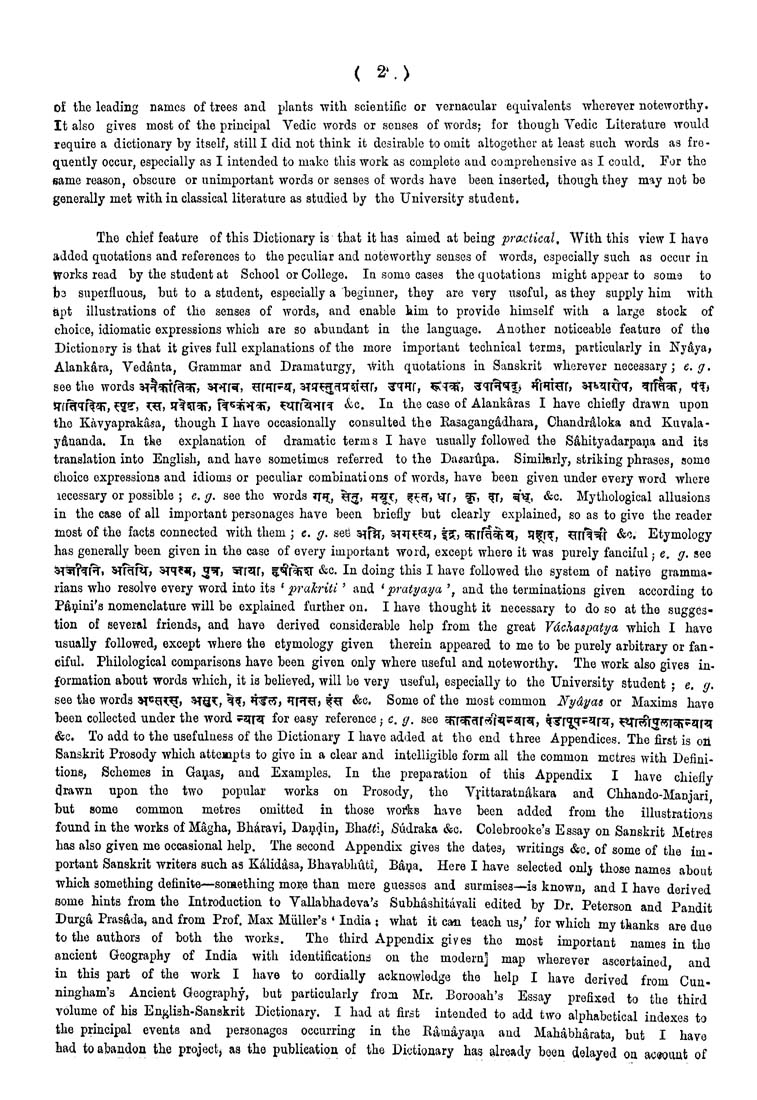( 2'.)
of the leading names of trees and plants with scientific or vernacular equivalents wherever noteworthy.
It also gives most of the principal Vedic words or senses of words; for though Vedic Literature would
require a dictionary by itself, still I did not think it desirable to omit altogether at least such words as fre¬
quently occur, especially as I intended to make this work as complete and comprehensive as I could. For the
same reason, obscure or unimportant words or senses of words have been inserted, though they may not be
generally met with in classical literature as studied by the University student.
The chief feature of this Dictionary is that it has aimed at being practical. With this view I have
added quotations and references to the peculiar and noteworthy senses of words, especially such as occur in
Works read by the student at School or College. In some cases the quotations might appear to some to
be superfluous, but to a student, especially a beginner, they are very useful, as they supply him with
cipt illustrations of the senses of words, and enable kim to provide himself with a large stock of
choice, idiomatic expressions which are so abundant in the language. Another noticeable feature of the
Dictionory is that it gives full explanations of the more important technical terms, particularly in Nydya,
Alankdra, Vedanta, Grammar and Dramaturgy, T^ith quotations in Sanskrit wherever necessary; e.g.
see the words ^^^f^^, 3T>Tr^, ^RF^T, ^sr^Hrfq-i^f^r; ^^f, ^T^, ^Tf^'srj^ ^mm, ^^m^^, ^rfW, tf*
^ff^T^f^^, ^S", ?:^, JTf ^^K", ^^^^cR-, ^^f%Hrf <^c. In the case of Alankaras I have chiefly dl?awn upon
the Kavyapraka^a, though I have occasionally consulted the Kasagangadhara, Chandrdloka and Kuvala-
ySfUanda. In the explanation of dramatic terms I have usually followed the Sdhityadarpa^ia and its
translation into English, and have sometimes referred to the Da^aiApa. Simikrly, striking phrases, some
choice expressions and idioms or peculiar combinations of words, have been given under every word where
lecessary or possible ; e.g. seethe words irJi;, ^g, H^, f^^> ^f; ^i V7 ^% &c. Mythological allusions
in the case of all important personages have been briefly but clearly explained, so as to give the reader
most of the facts connected with them ; e. g. se^ ^f?r, ^^^^^f, %^, ^m^% JJff^, ^FR^t &'5. Etymology
has generally been given in the case of every important word, except where it was purely fanciful • e, g. see
^^l^f^. ^l^ftr, ^i^^^i 3'3r, irr^r, f ^r%^ &c. in doing this I have followed the system of native gramma¬
rians who resolve every word into its ^ prahriti ' and ^ pratyaya ', and the terminations given according to
Pftijiini's nomenclature will be explained further on. I have thought it necessary to do so at the sugges¬
tion of several friends, and have derived considerable help from the great Ydchaspatya which I have
usually followed, except where the etymology given therein appeared to me to be purely arbitrary or fan¬
ciful. Philological comparisons have been given only where useful and noteworthy. The work also gives in¬
formation about words which, it is believed, will be very useful, especially to the University student ; e. g.
see the words ^e^qc;^, ^g^^ %^, ^^^, ^R^, f^ &c. Some of the most common Nydym or Maxims have
been collected under the word ?2TR for easy reference j c, g, see ^r^rfr«?'l«^^R, ^r'J?5:2^r^, ^trrt?r3?^r^?=z(r^
&c. To add to the usefulness of the Dictionary I have added at the end three Appendices. The first is on
Sanskrit Prosody which attempts to give in a clear and intelligible form all the common metres with Defini¬
tions, Schemes in Gai^as, and Examples. In the preparation of this Appendix I have chiefly
drawn upon the two popular works on Prosody, the Vi'ittaratndkara and Chhando-Manjari,
but some common metres omitted in those woi?ks have been added from the illustrations
found in the works of Magha, Bhdravi, Da}^(jiin, Bha^^i, Sudraka &c. Colebrooke's Essay on Sanskrit Metres
has also given me occasional help. The second Appendix gives the dates, writings &c. of some of the im-
portant Sanskrit writers such as Kdlidasa, Bhavabhuti, Bai;ia. Here I have selected only those names about
which something definite—something mol^e than mere guesses and surmises—is known, and I have derived
some hints from the Introduction to Vallabhadeva's Subhashitavali edited by Dr. Peterson and Pandit
Durga Prasada, and from Prof. Max MiiUer's * India ; what it can teach us,' for which my thanks are due
to the authors of both the works. The third Appendix gives the most important names in the
ancient Geography of India with identifications on the modern] map wherever ascertained and
in this part of the work I have to cordially acknowledge the help I have derived from' Cun-
ningham's Ancient Geography, but particularly from Mr. Borooah's Essay prefixed to the third
volume of his English-Sanskrit Dictionary. I had at first intended to add two alphabetical indexes to
the principal events and personages occurring in the Ramayaija and Mahabharata, but I have
had to abandon the project, as the publication of the Dictionary has already been delayed on account of
|








